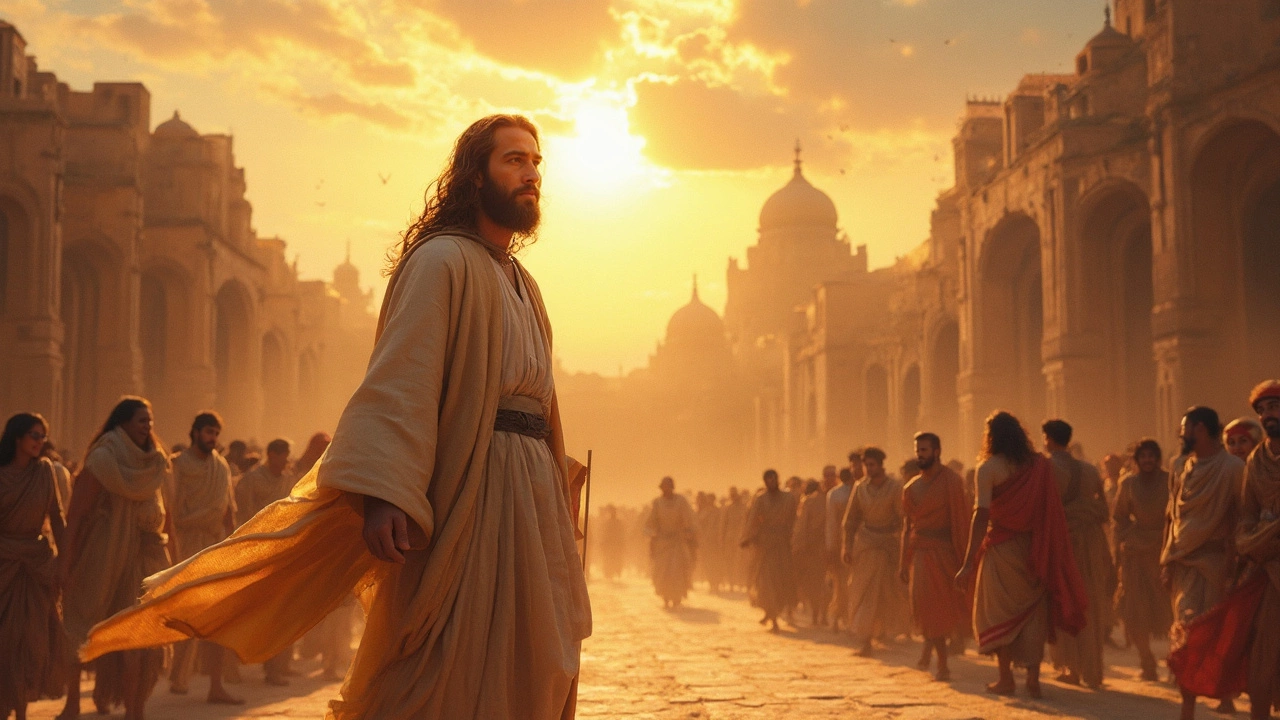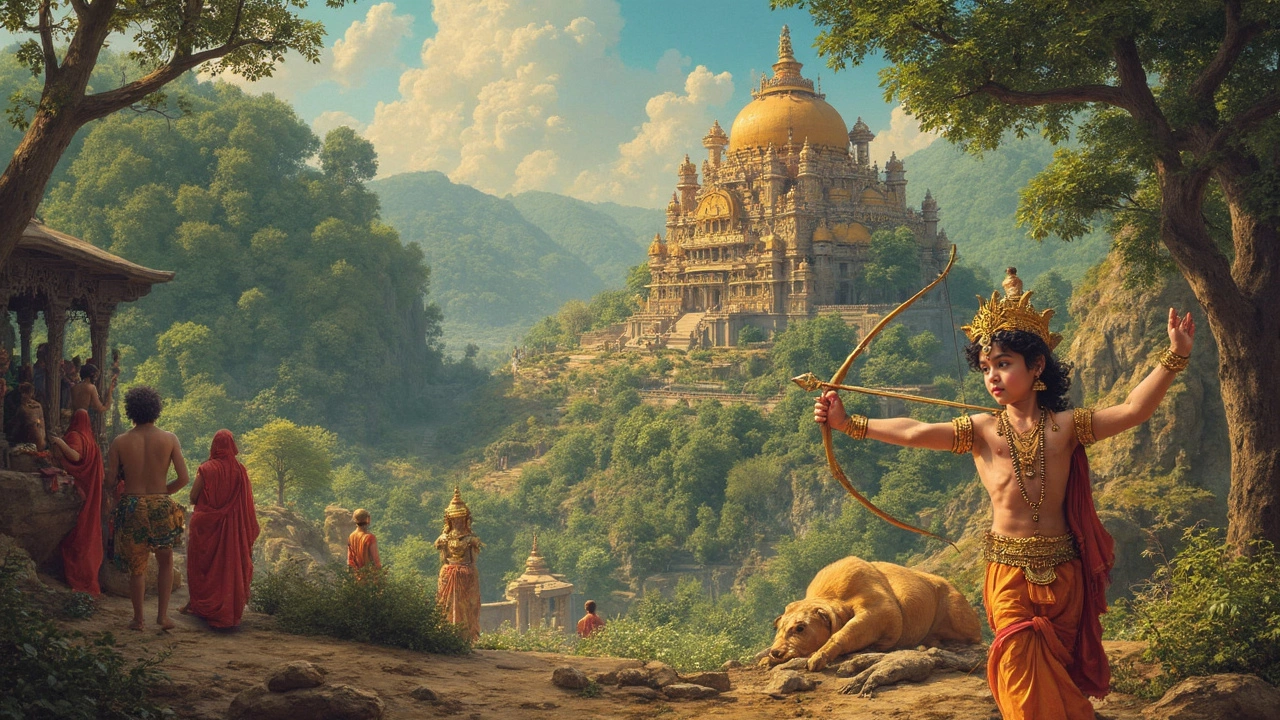So, who made their grand entrance into the world first, Rama or Jesus? This is the kind of dinner table debate that never fails to stir curiosity because it’s all about two of the most influential figures from myth and religion.
Let’s kick things off with some timelines. Rama, the hero of the great Indian epic, the Ramayana, has roots that dig deep into mythological history, possibly going back to ancient Indian civilization over 5000 years ago. Talk about a blast from the past! On the flip side, Jesus takes us back to a more recorded history, roughly 2025 years ago, during a time when Rome was flexing as a superpower.
The Ramayana paints a mesmerizing narrative around Rama’s birth. Born to King Dasharatha and Queen Kaushalya in Ayodhya, his arrival is celebrated with divine prophecies and plenty of celestial fanfare. It’s like an epic movie premiere set in ancient times. But it’s all part of his destiny to battle evil and establish righteousness.
- Understanding Their Timelines
- Rama's Birth Story
- The Significance of Jesus's Birth
- Cultural Impact Across Centuries
- Historical Evidence and Interpretations
- Concluding Thoughts on Their Legacies
Understanding Their Timelines
When you're getting into the stories of these legendary figures like Rama and Jesus, it’s all about piecing together timelines from both myth and historical accounts. It's not exactly like looking up someone’s birthday on Facebook.
Let’s start with Rama. His tale comes from the Ramayana and dates back thousands of years. Scholars suggest that his era could be around 5000 BCE, but pinning down the exact year is like trying to catch smoke with your hands. There aren't records like we have today—just oral traditions passed down generation to generation.
On the other hand, Jesus’s birth is somewhat easier to pinpoint, thanks to more documented history. Jesus was born during the reign of King Herod, around 4 BCE, which lands him in a time when historians were busy scribbling on parchment. The Roman Empire's influence makes this period one of the more documented times in ancient history.
Now, if you're wondering which came first by looking at recorded time, it’s pretty clear that Rama's story predates Jesus's by quite a stretch. However, some folks get all caught up in the spiritual or symbolic meaning instead.
To visualize this, take a look at this simplified timeline that gives you a rough idea:
| Figure | Approximate Era | Significance |
|---|---|---|
| Rama | ~5000 BCE | Embodiment of dharma |
| Jesus | ~4 BCE | Central figure of Christianity |
This table isn’t perfect since we're mixing myth with history, but it helps to sort out who potentially came when and adds some clarity to a fascinating, tangled net of timelines.
Rama's Birth Story
When it comes to Rama, his birth itself was a tale of divine intervention and cosmic plans. To set the scene, we have King Dasharatha, the virtuous ruler of Ayodhya, but he was missing one key piece of the royal puzzle—a heir to his throne. Quite the predicament, right?
Desperate to have children, the King performed a grand ritual known as the Putra Kamesti Yagna. Now, this wasn't just any old ritual; it was believed to summon the blessings of the gods themselves. The big moment came when a divine being emerged from the sacred fire, offering a bowl of special pudding to the king, instructing him to share it with his wives. Talk about divine dessert!
Dasharatha shared the pudding with his three wives—Kaushalya, Sumitra, and Kaikeyi. Nine months later, the celebration in the kingdom hit the roof. Rama was born to Queen Kaushalya, while his brothers, Bharata, Lakshmana, and Shatrughna, were also born to the other queens. Each of them played crucial roles in the epic adventures that would make up the Ramayana.
Rama's birth wasn't just important for the family. According to the epic, it was a cosmic necessity to rid the world of demons, particularly the mighty Ravana. His coming was prophesied to restore dharma, or righteousness, to the world. That's a hefty responsibility for a newborn, but hey, it was all in a day's work for Rama.
Many around the world remember this story, especially during festivals like Ram Navami, which celebrates Rama's birthday, bringing communities together to retell these ancient tales. And if you ever wondered about his lineage, here’s a fun fact table:
| Family Member | Relation |
|---|---|
| King Dasharatha | Father |
| Queen Kaushalya | Mother |
| Bharata | Brother |
| Lakshmana and Shatrughna | Brothers |
So, Rama wasn't just a mythological hero; he was a symbol of hope and evidence of divine plans set in motion to balance the world. Who knew birth stories could pack such a punch, right?
The Significance of Jesus's Birth
So let’s dive into why Jesus’s birth is such a big deal. First off, you’ve probably heard of Christmas, right? That's the holiday that marks this event, celebrated every year on December 25th. But beyond the festive lights and all that merry-making, Jesus's birth is believed to be a pivotal moment in history, especially for Christians.
The story kicks off in Bethlehem, a small town that's soaked in historical significance. According to the Gospels, Jesus was born to Mary and Joseph in a humble setting, often depicted as a stable or cave. This simplicity plays a huge role in highlighting the humility and accessibility of Jesus, as Christians believe that he was born to offer salvation not just to kings but to everyone.
Now, what makes this event stand out is the surrounding buzz. There's the Star of Bethlehem guiding the wise men, the prophecies predicting his birth, and the angelic announcements—all adding layers to the narrative of Jesus as the Messiah. This is a strong reason why his birth has captivated millions around the globe, slicing through time and cultures.
Beyond the stories, Jesus's arrival ties deeply with concepts of hope and redemption. For Christians, he’s not just a historical figure; he's the centerpiece of faith, symbolizing God's presence on Earth. This belief in his divine mission explains how his birth has shaped calendars, inspired art, and guided spiritual practices for centuries.

Cultural Impact Across Centuries
I mean, these guys aren't just historical figures, right? Rama and Jesus have both left an indelible mark across various cultures, shaping traditions, beliefs, and even daily life.
Let's chat about Rama first. In India, Rama's impact is everywhere—from festivals like Diwali, celebrated as the return of Rama to Ayodhya, to the countless versions of the Ramayana performed every year in folk theaters. Think of the Ram Leela—a theatrical performance that’s a must-see if you're ever in India during the festive season. These performances aren't just for show; they reinforce moral values and traditions that have been passed down for generations.
Now shifting gears to Jesus, his cultural footprint, as you probably know, is global. Christmas and Easter are celebrated in nearly every corner of the world, backed by customs and rituals that have evolved over centuries. But it’s not just the holidays. Jesus inspired the works of art, literature, and architecture that we still admire today. From Leonardo da Vinci’s
Historical Evidence and Interpretations
The question of who came first, Rama or Jesus, isn't as straightforward as checking birth certificates. Both figures are shrouded in layers of history, tradition, and a bit of mystery.
Let's start with Rama. Ancient Indian texts, primarily the Ramayana written by the sage Valmiki, are the main sources for Rama’s story. It’s kind of like the epic fantasy series of its time, but without a definite publication date. Scholars often date the events in the Ramayana to the Treta Yuga, which is a mystical era believed to be several thousand years ago. But pinning down exact years is like trying to catch water with a net—it just slips right through.
On the other hand, the historical evidence surrounding Jesus is a tad more concrete. The New Testament of the Bible, along with other historical documents from the Roman Empire, sheds more light. Jesus's birth is typically pegged at around 4 BC, which seems counterintuitive given our current calendar system. But hey, the monk who created the calendar we use today made a tiny mistake—imagine misplacing the birthday of one of history’s most significant figures by a few years!
Historians and archaeologists have long debated these dates, often looking for clues in everything from ancient texts to pottery shards. While Jesus's time has more corroborative historical records, both figures remain enigmatic and larger-than-life, captivating us with their timeless stories.
The evidence might be sketchy, but these narratives are rich with cultural and spiritual significance. Whether through sacred verses or ancient scrolls, the sheer impact of Rama and Jesus on millions throughout history can't be overstated.
Concluding Thoughts on Their Legacies
Rama and Jesus have left an indelible impact on cultures and religions around the world. Even though they were born in vastly different regions and eras, their stories have a common thread: they both embody ideals that people strive for—duty, compassion, and righteousness.
The legacy of Rama is closely tied to his role as a devoted son, a valiant hero, and a king who sacrificed his own happiness for the greater good. His influence is celebrated annually during festivals like Diwali, which marks his triumphant return to Ayodhya. This story continues to inspire countless followers to live a life of integrity and fulfillment.
On the other side of the world, Jesus' teachings emphasized love, forgiveness, and redemption. His life and message have been integral in shaping Western thought and values. The celebrations of Christmas and Easter mark significant events in his life, bringing communities together to celebrate his wisdom and sacrifice.
Despite the differences in their stories, both figures have shown us that their teachings transcend time and geography. They show us that these core values resonate deeply within human societies, regardless of when or where you are.
Moreover, through storytelling, art, and tradition, the tales of Rama and Jesus continue to be passed down through generations, ensuring that their legacies remain vibrant and influential. Whether it's the ancient epic recitations of Rama's adventures or the teachings of Jesus found in homes and churches around the globe, these narratives are woven into the fabric of human history, inspiring millions to live with hope and purpose.
